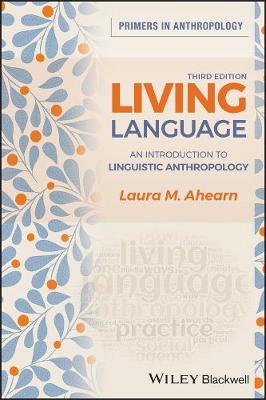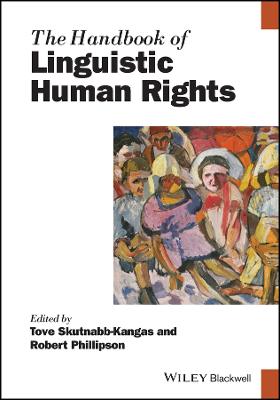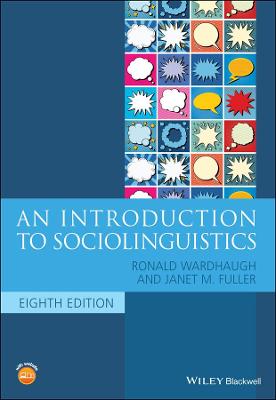Living Language
 -15%
portes grátis
-15%
portes grátis
Living Language
An Introduction to Linguistic Anthropology
Ahearn, Laura M.
John Wiley and Sons Ltd
03/2021
400
Mole
Inglês
9781119608141
15 a 20 dias
578
Descrição não disponível.
List of Figures ix
List of Tables xi
Preface xiii
Acknowledgments xix
Part I Language: Some Basic Questions 1
1 The Socially Charged Life of Language 3
So, What Do You Need to Know in Order to "Know" a Language? 9
Examples of Linguistic Diversity 13
Examples of Diversity in Research Topics in Linguistic Anthropology 17
Keith Basso 18
Marjorie Harness Goodwin 18
Bonnie Urciuoli 19
Alessandro Duranti 20
Kathryn A. Woolard 20
James M. Wilce 21
Key Terms in Linguistic Anthropology 21
Multifunctionality 22
Language Ideologies 24
Practice 26
Indexicality 29
The Inseparability of Language, Culture, and Social Relations 33
2 Gestures, Sign Languages, and Multimodality 35
Bakhtin's Double-Voiced Discourse 37
Goffman's Participation Framework and Production Format 38
Speech and the Analysis of Conversation 39
Gestures and Other Forms of Embodied Communication 42
Sign Languages 47
Poetry, Whistled Languages, Song, and Images 50
3 The Research Process in Linguistic Anthropology 54
What Kinds of Research Questions Do Linguistic Anthropologists Formulate? 55
What Kinds of Data Do Linguistic Anthropologists Collect, and with What Methods? 57
Participant Observation 58
Interviews 58
Surveys and Questionnaires 60
Naturally Occurring Conversations 60
Experimental Methods 62
Matched Guise Tests 63
Written Texts 64
How Do Linguistic Anthropologists Analyze Their Data? 64
What Products Do Linguistic Anthropologists Generate from their Research? 67
What Sorts of Ethical Issues Do Linguistic Anthropologists Face? 68
4 Language Acquisition and Socialization 72
Language Acquisition and the Socialization Process 74
Gaps in the "Language Gap" Approach 78
Language Socialization in Bilingual or Multilingual Contexts 81
Language Socialization throughout the Lifespan 84
Conclusion 88
5 Language, Thought, and Culture 90
A Hundred Years of Linguistic Relativity 91
The Sapir-Whorf Hypothesis 94
Investigating the Effects of Language on Thought 97
Language-in-General 98
Linguistic Structures 102
Color 106
Space 108
Time 110
Language Use 111
Conclusion 117
Part II Global Communities of Speakers, Hearers, Readers, and Writers 121
6 Global Communities of Multilingual Language Users 123
Defining "Speech Community" 124
Size and Location of the Community 124
What Is Shared by the Members of a Speech Community? 125
The Type of Interactions that Speech Community Members Have 125
Alternatives to the Concept of "Speech Community" 129
Speech Areas 129
Speech Networks 130
Communities of Practice 132
Multilingual and Transnational Linguistic Practices 136
Diglossia, Code-Mixing, and Code-Switching 144
Diglossia 145
Code-Switching 146
Code-Mixing 148
Heteroglossia 151
Conclusion 152
7 Literacy Practices 153
Literacy Events vs. Literacy Practices 155
"Autonomous" vs. "Ideological" Approaches to Studying Literacy 156
Some Examples of Situated Literacy Research 158
Preschool Literacy Practices in the Southeastern United States 158
Pema Kumari's letter 162
Love-letter Writing in Nepal 164
Instant Messaging: More like Speech or Writing? 166
8 Online Communities and Internet Linguistic Practices 170
Online Literacy Practices 171
Capitalization, Punctuation, and Emojis 172
Online Communities, Relationships, and Social Media 175
Who's Zoomin' Who? 177
Online Avatars 179
So Close and yet so Far 183
Conclusion 185
9 Performance, Performativity, and the Constitution of Communities 186
Performance Defined in Opposition to Competence 188
Performativity 189
Performance as a Display of Verbal Artistry 197
Ethnographies of Performance and Performativity 200
VIII Contents Part III Language, Power, and Social Differentiation 211
10 Language and Gender 213
What is Gender, and How Does it Relate to Language? 215
Do Men and Women Speak Alike or Differently? 221
Do Women and Men of All Ages and All Ethnic, Racial, and Cultural Backgrounds Share the Same Gendered Differences in Their Language Use? 233
Some Thoughts on Myths and Realities 237
11 Language, Race, and Ethnicity 240
Defining Race and Ethnicity 241
The Rule-Governed Nature of African American English 246
Invariant or Habitual "Be" 248
Copula Deletion 249
Double Negatives 250
The Reduction of Final Consonants 251
Pronouncing the Word "Ask" as "Aks" 252
Racist Language and Racism in Language 253
Language and Racial/Ethnic Identities 258
Conclusion 261
12 Language Endangerment and Revitalization 262
Enumerating the Crisis: How Many Endangered Languages are There? 265
What Dies When a Language Dies? 270
Why Do Languages Die? 276
Can Endangered Languages Be Saved? 278
Conclusion 280
13 Conclusion: Language, Power, and Agency 281
What Is Power? 283
Hegemony 284
Foucault's Power Relations and Discourse 285
Practice Theory and Power 287
Agency 298
The Grammatical Encoding of Agency 302
Talk About Agency: Meta-Agentive Discourse 305
Power and Agency In/through/by/of Language 310
Notes 313
References 328
Index 364
List of Tables xi
Preface xiii
Acknowledgments xix
Part I Language: Some Basic Questions 1
1 The Socially Charged Life of Language 3
So, What Do You Need to Know in Order to "Know" a Language? 9
Examples of Linguistic Diversity 13
Examples of Diversity in Research Topics in Linguistic Anthropology 17
Keith Basso 18
Marjorie Harness Goodwin 18
Bonnie Urciuoli 19
Alessandro Duranti 20
Kathryn A. Woolard 20
James M. Wilce 21
Key Terms in Linguistic Anthropology 21
Multifunctionality 22
Language Ideologies 24
Practice 26
Indexicality 29
The Inseparability of Language, Culture, and Social Relations 33
2 Gestures, Sign Languages, and Multimodality 35
Bakhtin's Double-Voiced Discourse 37
Goffman's Participation Framework and Production Format 38
Speech and the Analysis of Conversation 39
Gestures and Other Forms of Embodied Communication 42
Sign Languages 47
Poetry, Whistled Languages, Song, and Images 50
3 The Research Process in Linguistic Anthropology 54
What Kinds of Research Questions Do Linguistic Anthropologists Formulate? 55
What Kinds of Data Do Linguistic Anthropologists Collect, and with What Methods? 57
Participant Observation 58
Interviews 58
Surveys and Questionnaires 60
Naturally Occurring Conversations 60
Experimental Methods 62
Matched Guise Tests 63
Written Texts 64
How Do Linguistic Anthropologists Analyze Their Data? 64
What Products Do Linguistic Anthropologists Generate from their Research? 67
What Sorts of Ethical Issues Do Linguistic Anthropologists Face? 68
4 Language Acquisition and Socialization 72
Language Acquisition and the Socialization Process 74
Gaps in the "Language Gap" Approach 78
Language Socialization in Bilingual or Multilingual Contexts 81
Language Socialization throughout the Lifespan 84
Conclusion 88
5 Language, Thought, and Culture 90
A Hundred Years of Linguistic Relativity 91
The Sapir-Whorf Hypothesis 94
Investigating the Effects of Language on Thought 97
Language-in-General 98
Linguistic Structures 102
Color 106
Space 108
Time 110
Language Use 111
Conclusion 117
Part II Global Communities of Speakers, Hearers, Readers, and Writers 121
6 Global Communities of Multilingual Language Users 123
Defining "Speech Community" 124
Size and Location of the Community 124
What Is Shared by the Members of a Speech Community? 125
The Type of Interactions that Speech Community Members Have 125
Alternatives to the Concept of "Speech Community" 129
Speech Areas 129
Speech Networks 130
Communities of Practice 132
Multilingual and Transnational Linguistic Practices 136
Diglossia, Code-Mixing, and Code-Switching 144
Diglossia 145
Code-Switching 146
Code-Mixing 148
Heteroglossia 151
Conclusion 152
7 Literacy Practices 153
Literacy Events vs. Literacy Practices 155
"Autonomous" vs. "Ideological" Approaches to Studying Literacy 156
Some Examples of Situated Literacy Research 158
Preschool Literacy Practices in the Southeastern United States 158
Pema Kumari's letter 162
Love-letter Writing in Nepal 164
Instant Messaging: More like Speech or Writing? 166
8 Online Communities and Internet Linguistic Practices 170
Online Literacy Practices 171
Capitalization, Punctuation, and Emojis 172
Online Communities, Relationships, and Social Media 175
Who's Zoomin' Who? 177
Online Avatars 179
So Close and yet so Far 183
Conclusion 185
9 Performance, Performativity, and the Constitution of Communities 186
Performance Defined in Opposition to Competence 188
Performativity 189
Performance as a Display of Verbal Artistry 197
Ethnographies of Performance and Performativity 200
VIII Contents Part III Language, Power, and Social Differentiation 211
10 Language and Gender 213
What is Gender, and How Does it Relate to Language? 215
Do Men and Women Speak Alike or Differently? 221
Do Women and Men of All Ages and All Ethnic, Racial, and Cultural Backgrounds Share the Same Gendered Differences in Their Language Use? 233
Some Thoughts on Myths and Realities 237
11 Language, Race, and Ethnicity 240
Defining Race and Ethnicity 241
The Rule-Governed Nature of African American English 246
Invariant or Habitual "Be" 248
Copula Deletion 249
Double Negatives 250
The Reduction of Final Consonants 251
Pronouncing the Word "Ask" as "Aks" 252
Racist Language and Racism in Language 253
Language and Racial/Ethnic Identities 258
Conclusion 261
12 Language Endangerment and Revitalization 262
Enumerating the Crisis: How Many Endangered Languages are There? 265
What Dies When a Language Dies? 270
Why Do Languages Die? 276
Can Endangered Languages Be Saved? 278
Conclusion 280
13 Conclusion: Language, Power, and Agency 281
What Is Power? 283
Hegemony 284
Foucault's Power Relations and Discourse 285
Practice Theory and Power 287
Agency 298
The Grammatical Encoding of Agency 302
Talk About Agency: Meta-Agentive Discourse 305
Power and Agency In/through/by/of Language 310
Notes 313
References 328
Index 364
Este título pertence ao(s) assunto(s) indicados(s). Para ver outros títulos clique no assunto desejado.
linguistic anthropology textbook; linguistic anthropology introduction; linguistics textbook; linguistic anthropology research; linguistic diversity; linguistics social theory; language theory; linguistic communities; linguistic practice; semiosis; language and culture; language and society
List of Figures ix
List of Tables xi
Preface xiii
Acknowledgments xix
Part I Language: Some Basic Questions 1
1 The Socially Charged Life of Language 3
So, What Do You Need to Know in Order to "Know" a Language? 9
Examples of Linguistic Diversity 13
Examples of Diversity in Research Topics in Linguistic Anthropology 17
Keith Basso 18
Marjorie Harness Goodwin 18
Bonnie Urciuoli 19
Alessandro Duranti 20
Kathryn A. Woolard 20
James M. Wilce 21
Key Terms in Linguistic Anthropology 21
Multifunctionality 22
Language Ideologies 24
Practice 26
Indexicality 29
The Inseparability of Language, Culture, and Social Relations 33
2 Gestures, Sign Languages, and Multimodality 35
Bakhtin's Double-Voiced Discourse 37
Goffman's Participation Framework and Production Format 38
Speech and the Analysis of Conversation 39
Gestures and Other Forms of Embodied Communication 42
Sign Languages 47
Poetry, Whistled Languages, Song, and Images 50
3 The Research Process in Linguistic Anthropology 54
What Kinds of Research Questions Do Linguistic Anthropologists Formulate? 55
What Kinds of Data Do Linguistic Anthropologists Collect, and with What Methods? 57
Participant Observation 58
Interviews 58
Surveys and Questionnaires 60
Naturally Occurring Conversations 60
Experimental Methods 62
Matched Guise Tests 63
Written Texts 64
How Do Linguistic Anthropologists Analyze Their Data? 64
What Products Do Linguistic Anthropologists Generate from their Research? 67
What Sorts of Ethical Issues Do Linguistic Anthropologists Face? 68
4 Language Acquisition and Socialization 72
Language Acquisition and the Socialization Process 74
Gaps in the "Language Gap" Approach 78
Language Socialization in Bilingual or Multilingual Contexts 81
Language Socialization throughout the Lifespan 84
Conclusion 88
5 Language, Thought, and Culture 90
A Hundred Years of Linguistic Relativity 91
The Sapir-Whorf Hypothesis 94
Investigating the Effects of Language on Thought 97
Language-in-General 98
Linguistic Structures 102
Color 106
Space 108
Time 110
Language Use 111
Conclusion 117
Part II Global Communities of Speakers, Hearers, Readers, and Writers 121
6 Global Communities of Multilingual Language Users 123
Defining "Speech Community" 124
Size and Location of the Community 124
What Is Shared by the Members of a Speech Community? 125
The Type of Interactions that Speech Community Members Have 125
Alternatives to the Concept of "Speech Community" 129
Speech Areas 129
Speech Networks 130
Communities of Practice 132
Multilingual and Transnational Linguistic Practices 136
Diglossia, Code-Mixing, and Code-Switching 144
Diglossia 145
Code-Switching 146
Code-Mixing 148
Heteroglossia 151
Conclusion 152
7 Literacy Practices 153
Literacy Events vs. Literacy Practices 155
"Autonomous" vs. "Ideological" Approaches to Studying Literacy 156
Some Examples of Situated Literacy Research 158
Preschool Literacy Practices in the Southeastern United States 158
Pema Kumari's letter 162
Love-letter Writing in Nepal 164
Instant Messaging: More like Speech or Writing? 166
8 Online Communities and Internet Linguistic Practices 170
Online Literacy Practices 171
Capitalization, Punctuation, and Emojis 172
Online Communities, Relationships, and Social Media 175
Who's Zoomin' Who? 177
Online Avatars 179
So Close and yet so Far 183
Conclusion 185
9 Performance, Performativity, and the Constitution of Communities 186
Performance Defined in Opposition to Competence 188
Performativity 189
Performance as a Display of Verbal Artistry 197
Ethnographies of Performance and Performativity 200
VIII Contents Part III Language, Power, and Social Differentiation 211
10 Language and Gender 213
What is Gender, and How Does it Relate to Language? 215
Do Men and Women Speak Alike or Differently? 221
Do Women and Men of All Ages and All Ethnic, Racial, and Cultural Backgrounds Share the Same Gendered Differences in Their Language Use? 233
Some Thoughts on Myths and Realities 237
11 Language, Race, and Ethnicity 240
Defining Race and Ethnicity 241
The Rule-Governed Nature of African American English 246
Invariant or Habitual "Be" 248
Copula Deletion 249
Double Negatives 250
The Reduction of Final Consonants 251
Pronouncing the Word "Ask" as "Aks" 252
Racist Language and Racism in Language 253
Language and Racial/Ethnic Identities 258
Conclusion 261
12 Language Endangerment and Revitalization 262
Enumerating the Crisis: How Many Endangered Languages are There? 265
What Dies When a Language Dies? 270
Why Do Languages Die? 276
Can Endangered Languages Be Saved? 278
Conclusion 280
13 Conclusion: Language, Power, and Agency 281
What Is Power? 283
Hegemony 284
Foucault's Power Relations and Discourse 285
Practice Theory and Power 287
Agency 298
The Grammatical Encoding of Agency 302
Talk About Agency: Meta-Agentive Discourse 305
Power and Agency In/through/by/of Language 310
Notes 313
References 328
Index 364
List of Tables xi
Preface xiii
Acknowledgments xix
Part I Language: Some Basic Questions 1
1 The Socially Charged Life of Language 3
So, What Do You Need to Know in Order to "Know" a Language? 9
Examples of Linguistic Diversity 13
Examples of Diversity in Research Topics in Linguistic Anthropology 17
Keith Basso 18
Marjorie Harness Goodwin 18
Bonnie Urciuoli 19
Alessandro Duranti 20
Kathryn A. Woolard 20
James M. Wilce 21
Key Terms in Linguistic Anthropology 21
Multifunctionality 22
Language Ideologies 24
Practice 26
Indexicality 29
The Inseparability of Language, Culture, and Social Relations 33
2 Gestures, Sign Languages, and Multimodality 35
Bakhtin's Double-Voiced Discourse 37
Goffman's Participation Framework and Production Format 38
Speech and the Analysis of Conversation 39
Gestures and Other Forms of Embodied Communication 42
Sign Languages 47
Poetry, Whistled Languages, Song, and Images 50
3 The Research Process in Linguistic Anthropology 54
What Kinds of Research Questions Do Linguistic Anthropologists Formulate? 55
What Kinds of Data Do Linguistic Anthropologists Collect, and with What Methods? 57
Participant Observation 58
Interviews 58
Surveys and Questionnaires 60
Naturally Occurring Conversations 60
Experimental Methods 62
Matched Guise Tests 63
Written Texts 64
How Do Linguistic Anthropologists Analyze Their Data? 64
What Products Do Linguistic Anthropologists Generate from their Research? 67
What Sorts of Ethical Issues Do Linguistic Anthropologists Face? 68
4 Language Acquisition and Socialization 72
Language Acquisition and the Socialization Process 74
Gaps in the "Language Gap" Approach 78
Language Socialization in Bilingual or Multilingual Contexts 81
Language Socialization throughout the Lifespan 84
Conclusion 88
5 Language, Thought, and Culture 90
A Hundred Years of Linguistic Relativity 91
The Sapir-Whorf Hypothesis 94
Investigating the Effects of Language on Thought 97
Language-in-General 98
Linguistic Structures 102
Color 106
Space 108
Time 110
Language Use 111
Conclusion 117
Part II Global Communities of Speakers, Hearers, Readers, and Writers 121
6 Global Communities of Multilingual Language Users 123
Defining "Speech Community" 124
Size and Location of the Community 124
What Is Shared by the Members of a Speech Community? 125
The Type of Interactions that Speech Community Members Have 125
Alternatives to the Concept of "Speech Community" 129
Speech Areas 129
Speech Networks 130
Communities of Practice 132
Multilingual and Transnational Linguistic Practices 136
Diglossia, Code-Mixing, and Code-Switching 144
Diglossia 145
Code-Switching 146
Code-Mixing 148
Heteroglossia 151
Conclusion 152
7 Literacy Practices 153
Literacy Events vs. Literacy Practices 155
"Autonomous" vs. "Ideological" Approaches to Studying Literacy 156
Some Examples of Situated Literacy Research 158
Preschool Literacy Practices in the Southeastern United States 158
Pema Kumari's letter 162
Love-letter Writing in Nepal 164
Instant Messaging: More like Speech or Writing? 166
8 Online Communities and Internet Linguistic Practices 170
Online Literacy Practices 171
Capitalization, Punctuation, and Emojis 172
Online Communities, Relationships, and Social Media 175
Who's Zoomin' Who? 177
Online Avatars 179
So Close and yet so Far 183
Conclusion 185
9 Performance, Performativity, and the Constitution of Communities 186
Performance Defined in Opposition to Competence 188
Performativity 189
Performance as a Display of Verbal Artistry 197
Ethnographies of Performance and Performativity 200
VIII Contents Part III Language, Power, and Social Differentiation 211
10 Language and Gender 213
What is Gender, and How Does it Relate to Language? 215
Do Men and Women Speak Alike or Differently? 221
Do Women and Men of All Ages and All Ethnic, Racial, and Cultural Backgrounds Share the Same Gendered Differences in Their Language Use? 233
Some Thoughts on Myths and Realities 237
11 Language, Race, and Ethnicity 240
Defining Race and Ethnicity 241
The Rule-Governed Nature of African American English 246
Invariant or Habitual "Be" 248
Copula Deletion 249
Double Negatives 250
The Reduction of Final Consonants 251
Pronouncing the Word "Ask" as "Aks" 252
Racist Language and Racism in Language 253
Language and Racial/Ethnic Identities 258
Conclusion 261
12 Language Endangerment and Revitalization 262
Enumerating the Crisis: How Many Endangered Languages are There? 265
What Dies When a Language Dies? 270
Why Do Languages Die? 276
Can Endangered Languages Be Saved? 278
Conclusion 280
13 Conclusion: Language, Power, and Agency 281
What Is Power? 283
Hegemony 284
Foucault's Power Relations and Discourse 285
Practice Theory and Power 287
Agency 298
The Grammatical Encoding of Agency 302
Talk About Agency: Meta-Agentive Discourse 305
Power and Agency In/through/by/of Language 310
Notes 313
References 328
Index 364
Este título pertence ao(s) assunto(s) indicados(s). Para ver outros títulos clique no assunto desejado.







